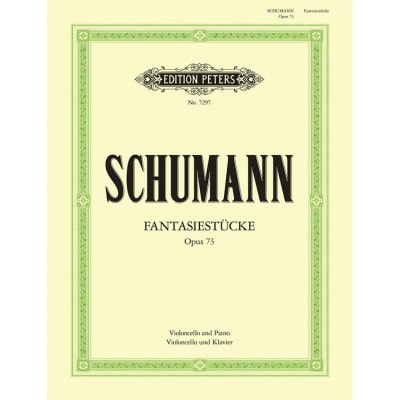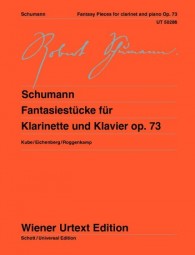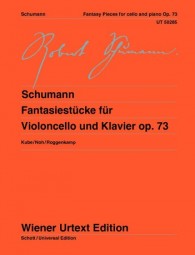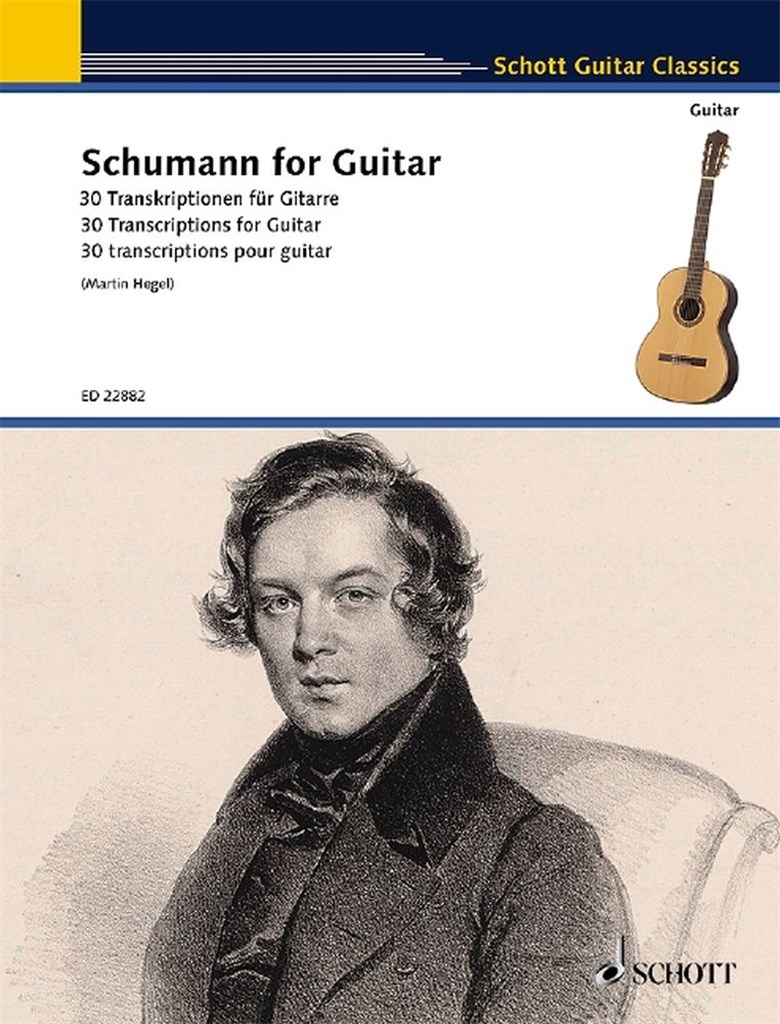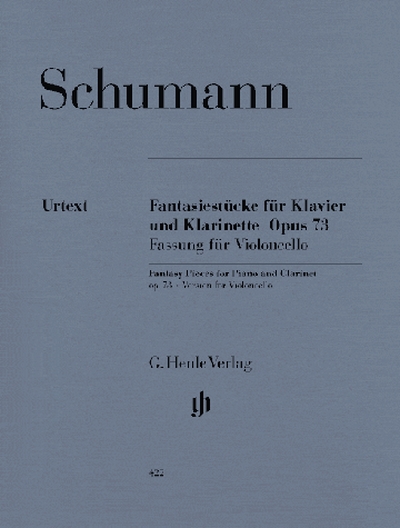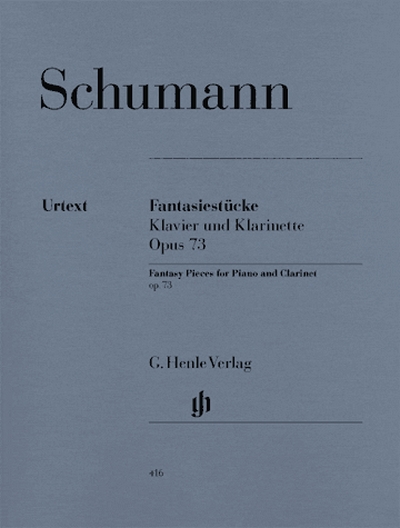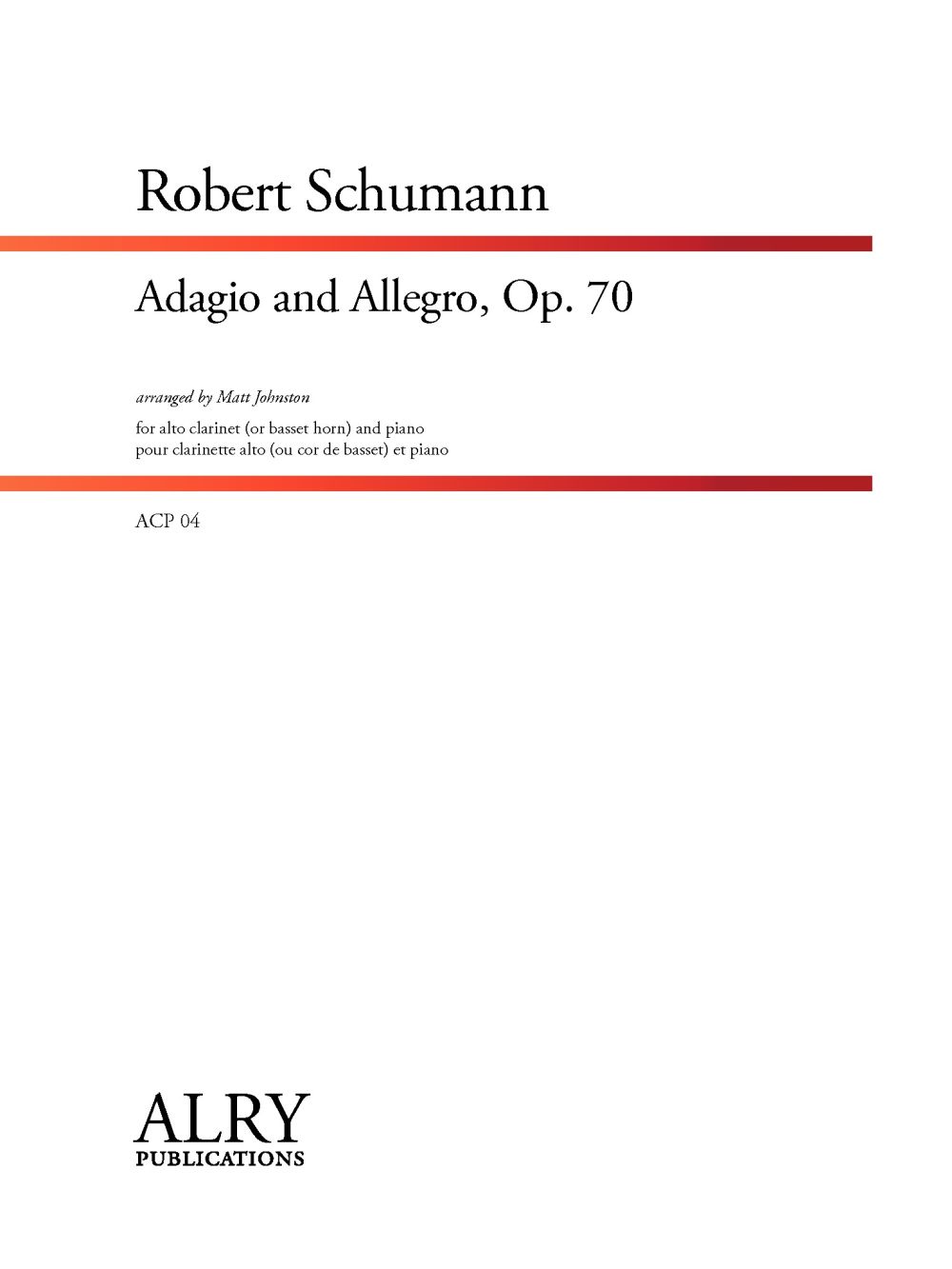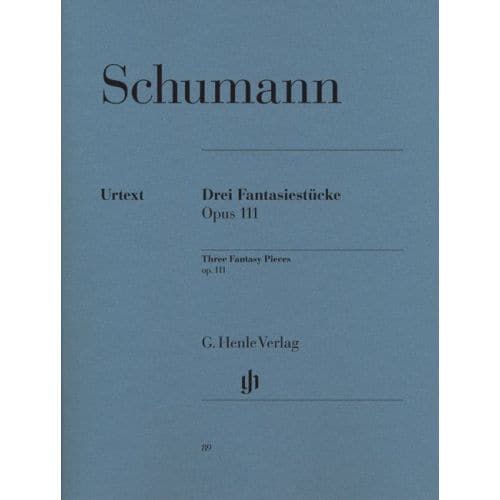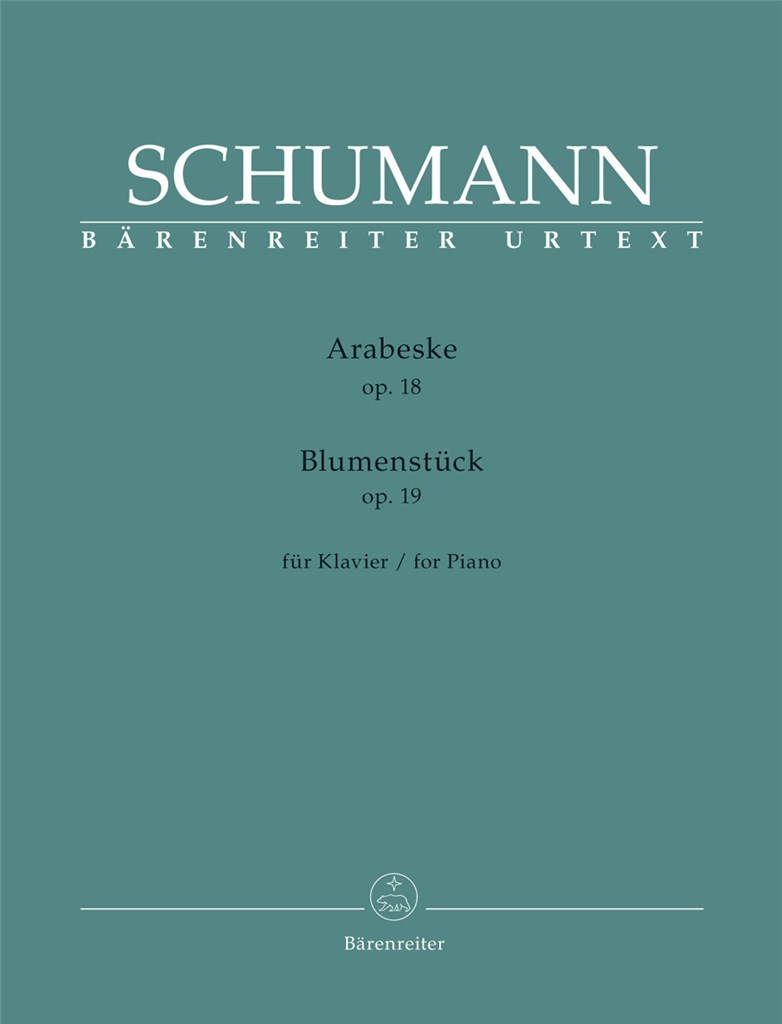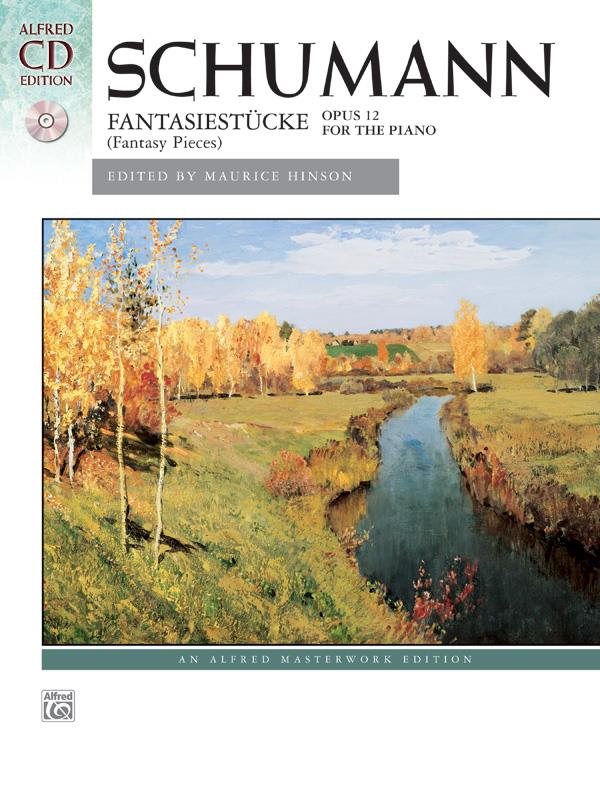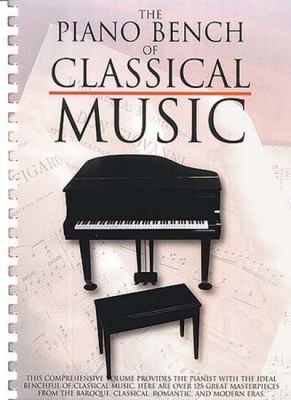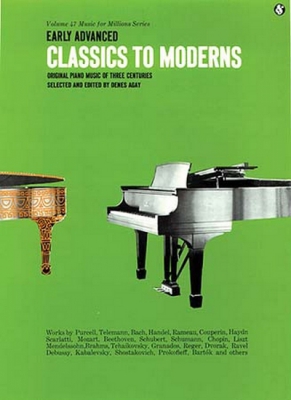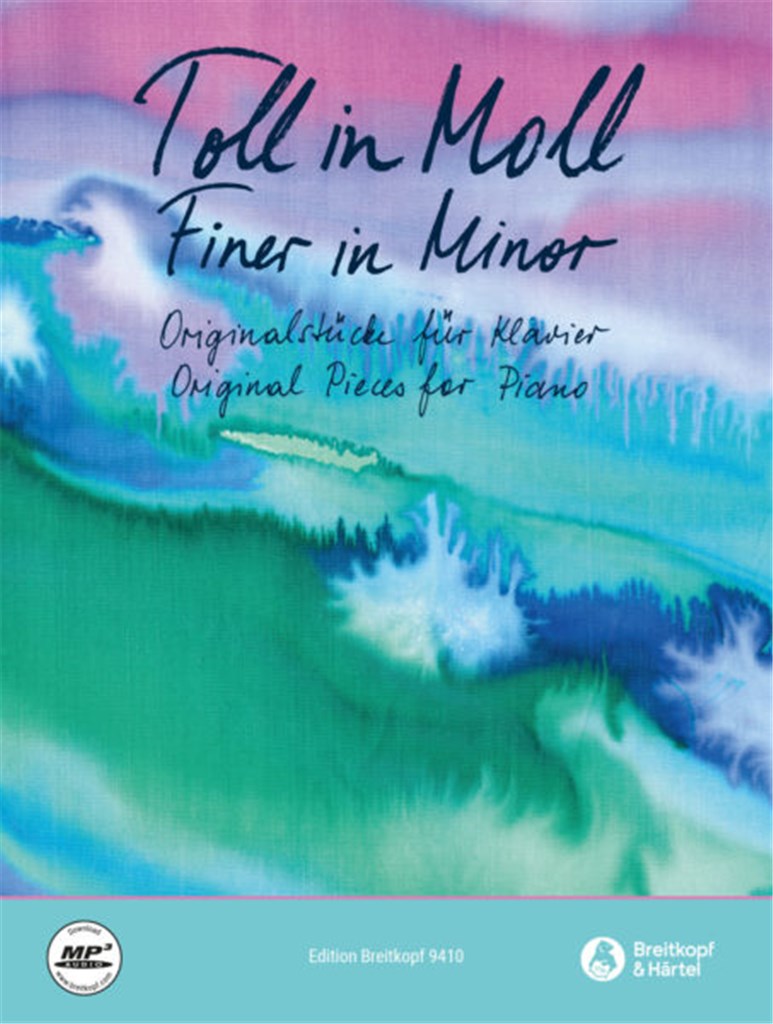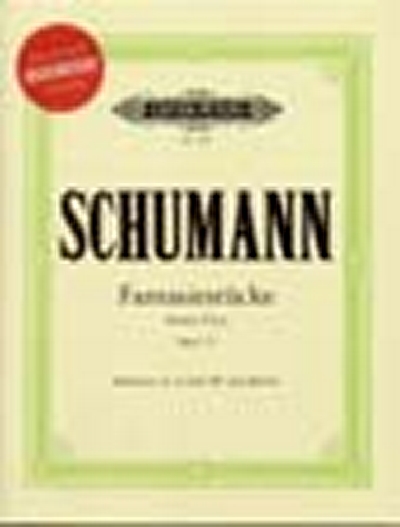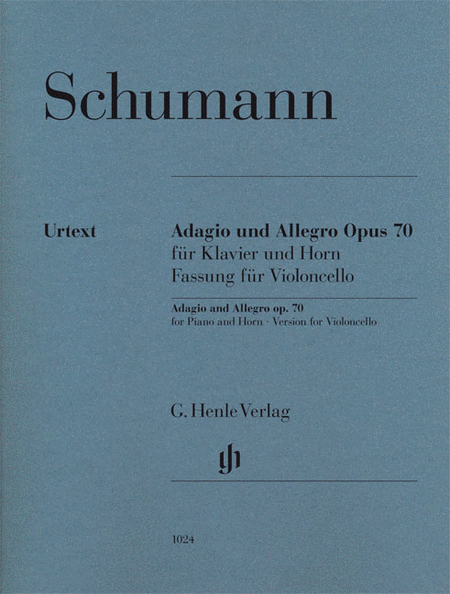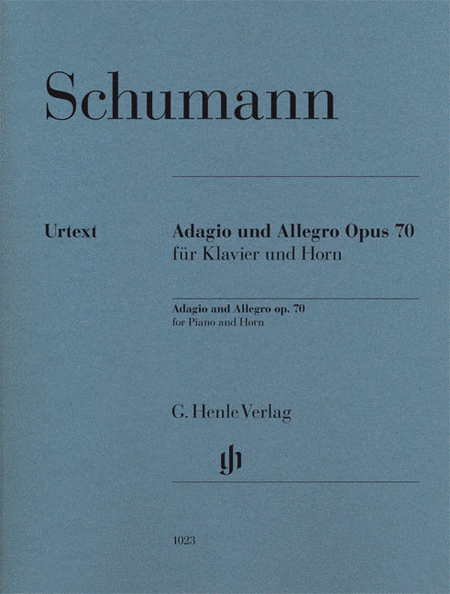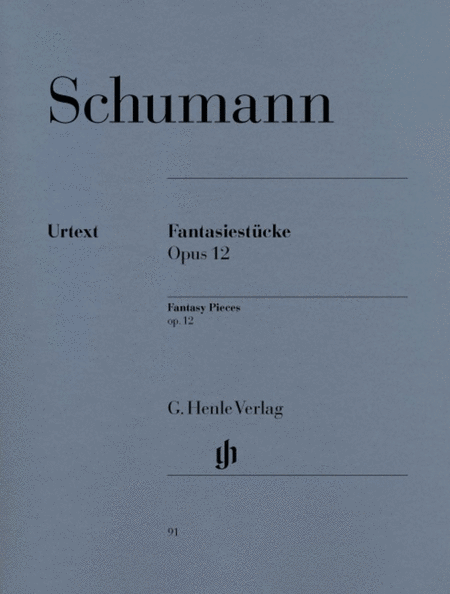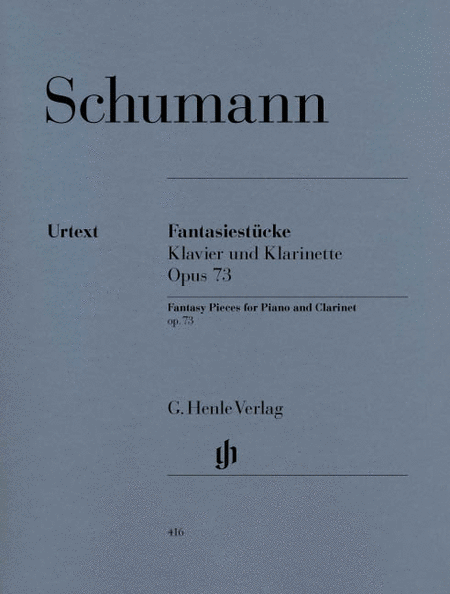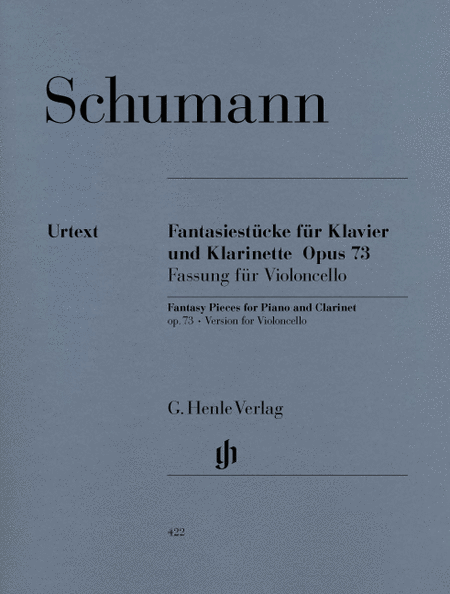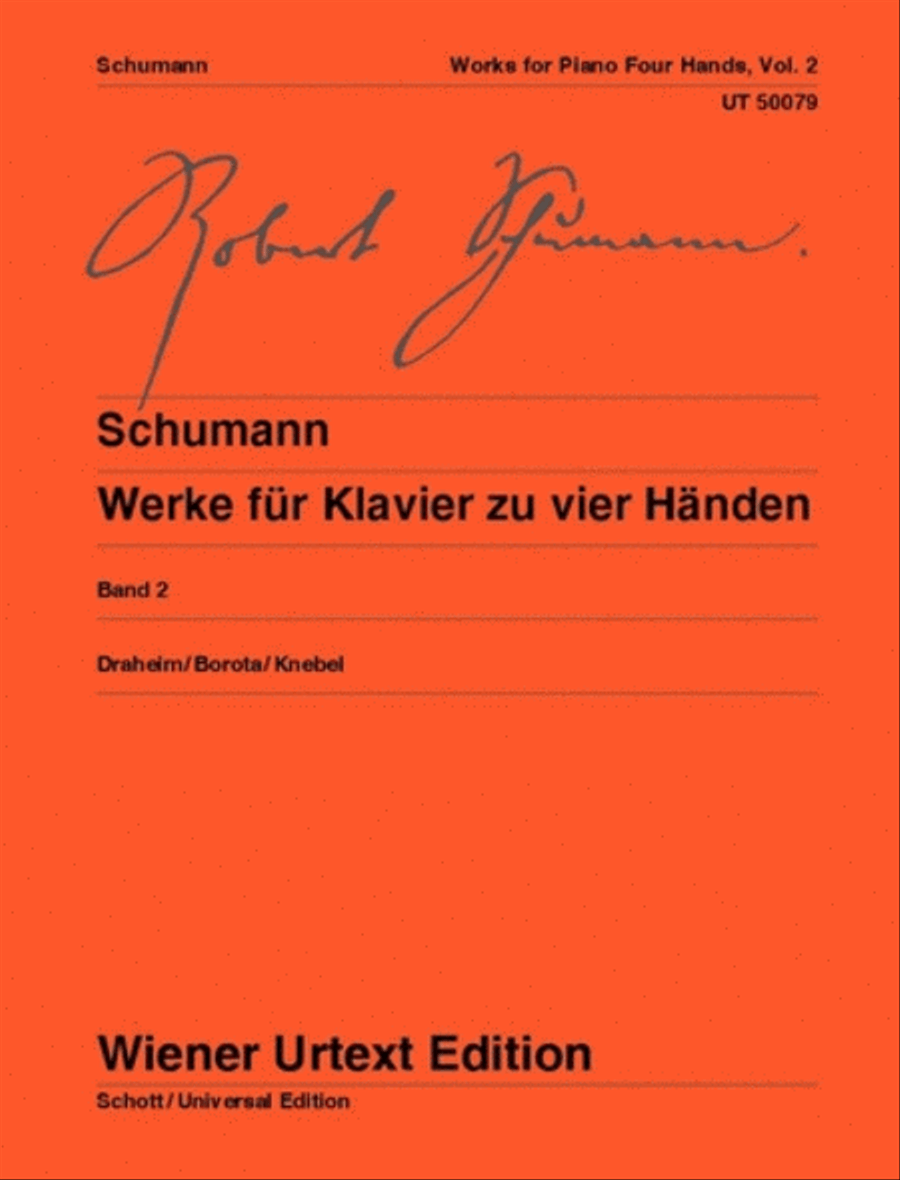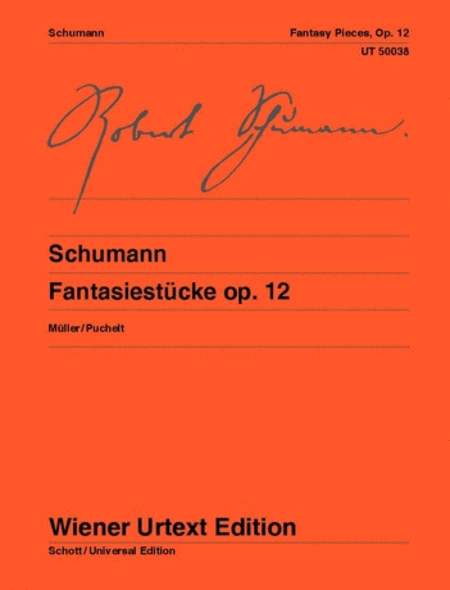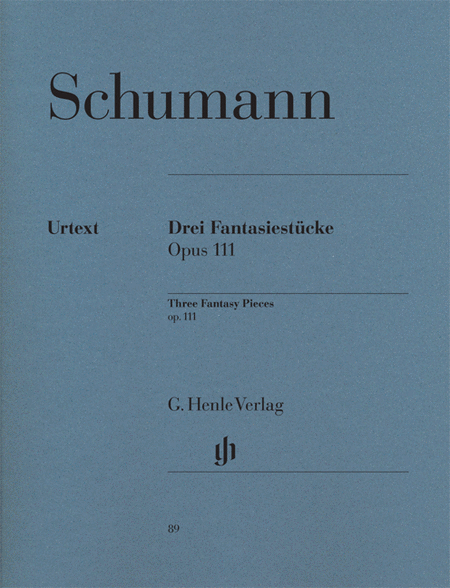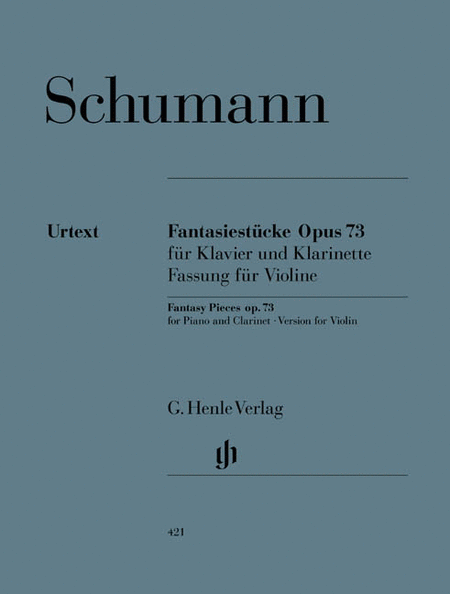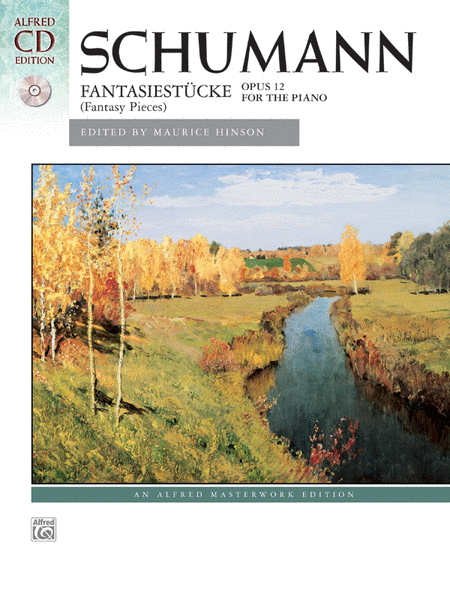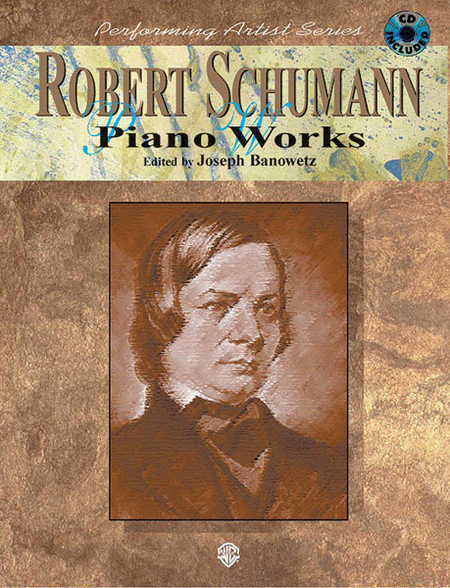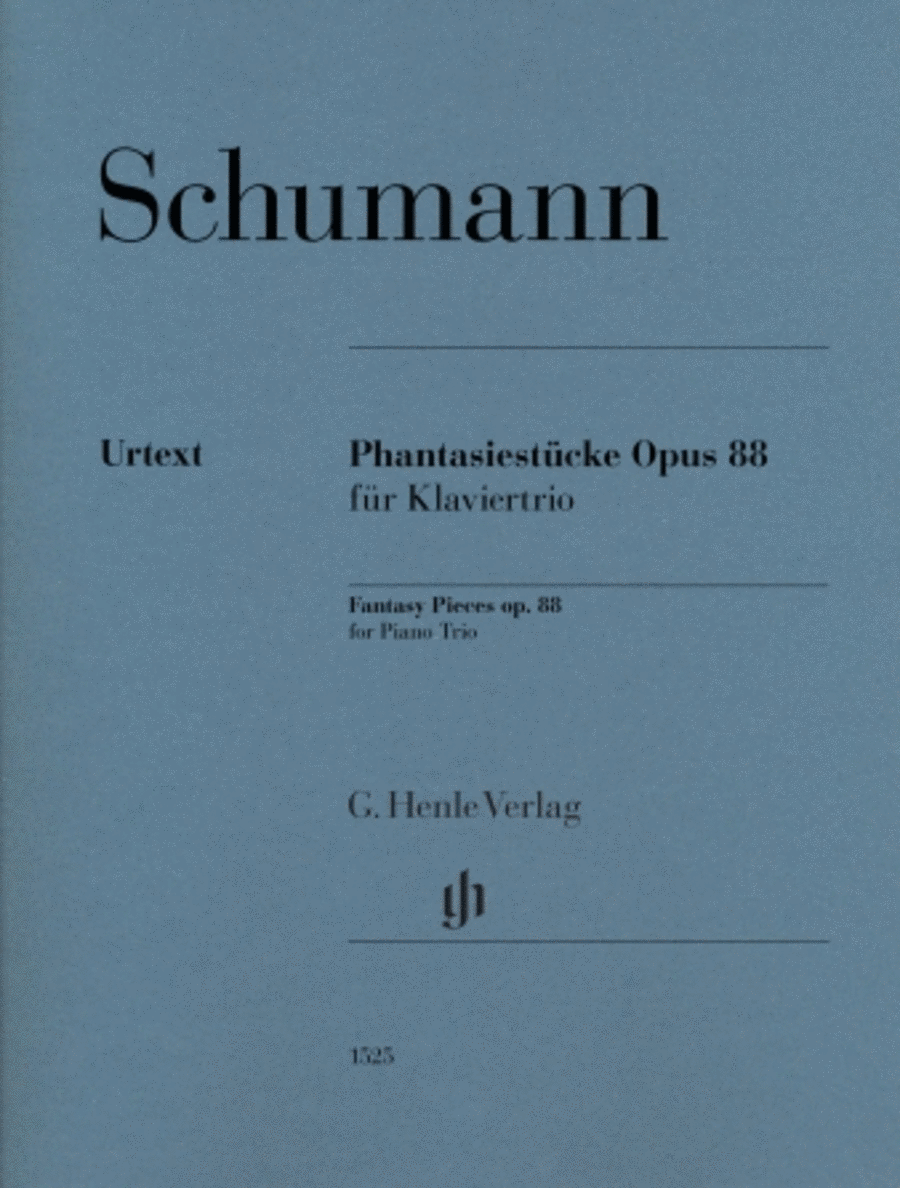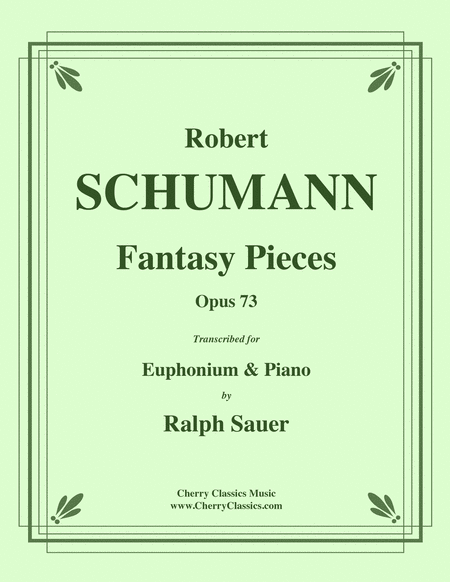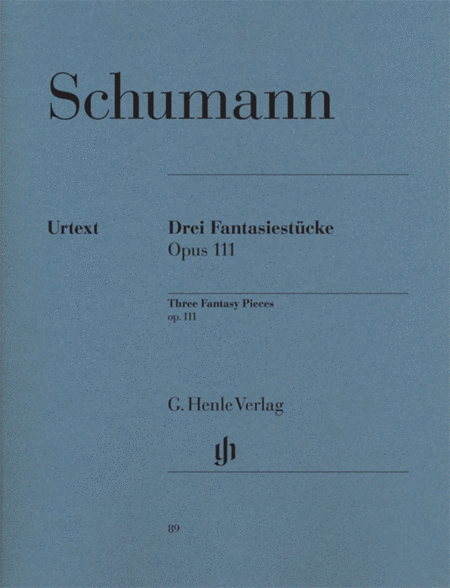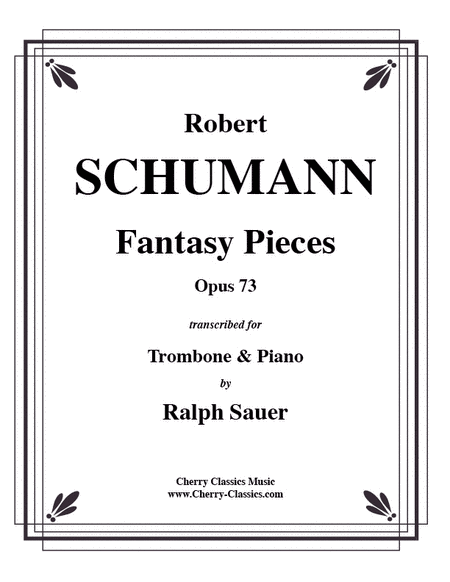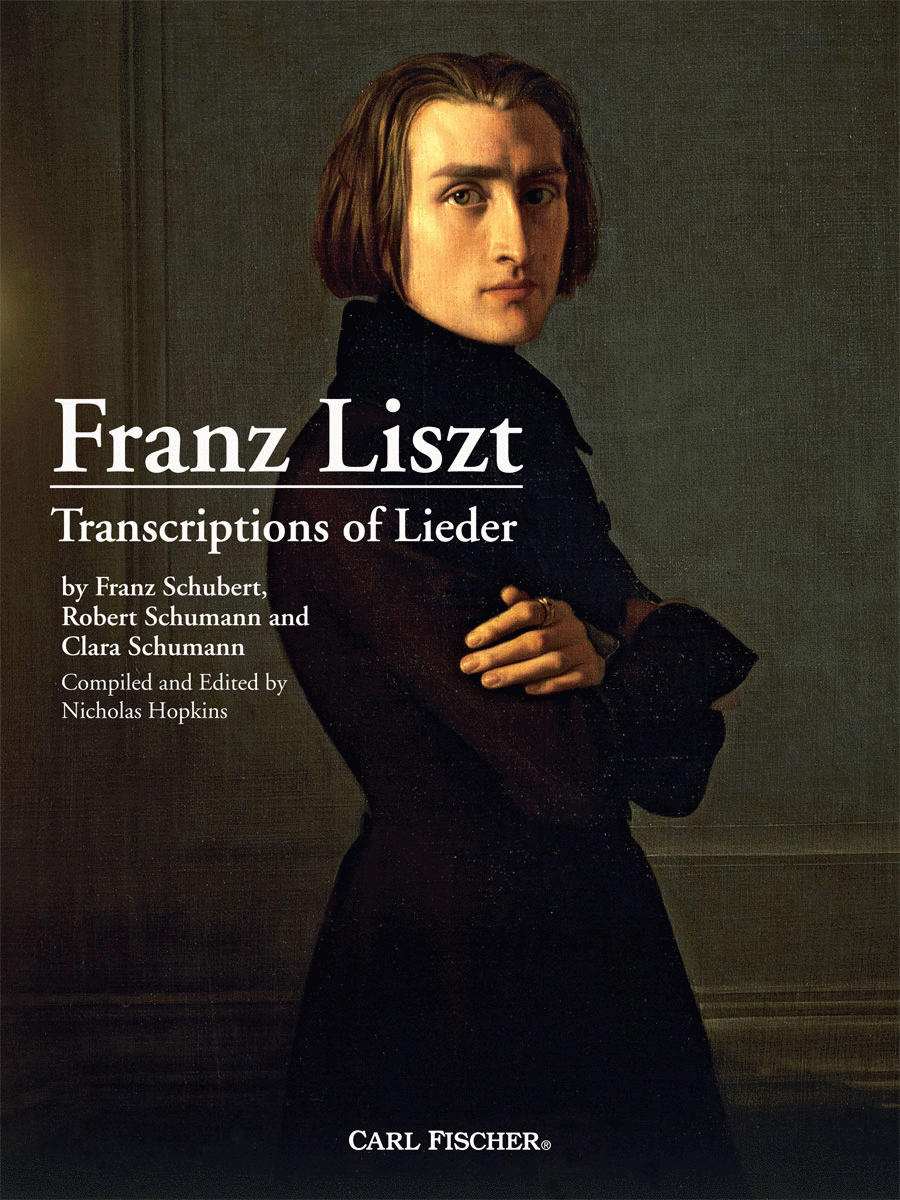|
| Fantasy Pieces For
Clarinet And Piano Op. 73
Clarinette et Piano
Wiener Urtext
Robert Schumann wrote his Fantasy Pieces for clarinet and piano in the course of...(+)
Robert Schumann wrote his Fantasy Pieces for clarinet and piano in the course of two days in February 1849. Only a few days later they were premiered by Clara Schumann and the Dresden clarinetist Johann Gottlieb Kotte. Initially choosing the title Soirée Pieces for his works, Schumann finally decided to have them published as Fantasy Pieces, thereby emphasizing their poetical aspects. These connotations are also at the centre of clarinetist Elisabeth Eichenberg's notes on interpretation with special reference to the contemporary aesthetics of the clarinet sound. The edition is based on the first edition published in 1849 and also incorporates subsequent corrections in Schumann's personal copy. The compositional manuscript that has survived served as an important corrective. Besides the original clarinet part in A the edition also includes a transposed part for the B clarinet in order to make these standard works of the Romantic clarinet repertoire available to a wider circle of the clarinet community. / Clarinette Et Piano
Délais: En Stock | | |
| Fantasy Pieces For
Violoncello And Piano Op.
73
Violoncelle, Piano
Wiener Urtext
Written in just two days in February 1849, Robert Schumann's Fantasy Pieces Op. ...(+)
Written in just two days in February 1849, Robert Schumann's Fantasy Pieces Op. 73 were first performed by his wife Clara and the clarinettist Johann Gottlieb Kotte. Initially entitled Soirée Pieces, the composer later had the works published under the name of Fantasy Pieces, thus establishing a connection with poetical aspects. The first edition published in July 1849 contained not only a clarinet part but also a violin and cello part. Since then, they have become an integral part of the Romantic repertoire for cello and piano. This edition is based on the text of the first edition as well as on subsequent corrections from Schumann's personal copy, with the extant composition manuscript serving as an important corrective. / Violoncelle Et Piano
Délais: 2-5 jours - En Stock Fournisseur | | |
| Selected Works For Solo
Piano - Vol.1 (Urtext
Edition) (SCHUMANN
ROBERT)
Piano seul [Partition] - Intermédiaire/avancé
Dover Publications
Par SCHUMANN ROBERT. Edité et gravé par Ephraim Jones Hammett, Volume I de cet...(+)
Par SCHUMANN ROBERT. Edité et gravé par Ephraim Jones Hammett, Volume I de cet ensemble de deux ouvrage présente une compilation originale des pièces de Robert Schumann caractères les plus connus et les cycles de piano dans une édition Urtext vierge. Imprimé à reproduire précisément les intentions originales de l'artiste, il dispose de treize des plus belles oeuvres du compositeur romantique.
Convient aux pianistes de niveau intermédiaire avancé, le contenu renferme Fantasy Pieces, op. 12- Symphonic Etudes, Op.. 13- Toccata op. 7- Variations sur le nom 'Abegg', op. 1- Scènes d'enfants op. 15- Kreisleriana op. 16- Arabeske, op. 18- Blumenstück, op. 19- Humoreske op. 20 et scènes de forêt, op. 82. / Niveau : Intermédiaire à Avancé / Répertoire / Piano
Délais: 2-5 jours - En Stock Fournisseur | | |
| Schumann For Guitar
(Arr.Martin Hegel)
Guitare [Partition]
Schott
30 Transcriptions. Par SCHUMANN ROBERT. The edition Schumann for Guitar is an in...(+)
30 Transcriptions. Par SCHUMANN ROBERT. The edition Schumann for Guitar is an interesting attempt to transfer Robert Schumann's romantic, lyrical music to the guitar. As a consequence, new tonal possibilities present themselves for the guitar repertoire, particularly in view of the fact that Schumann himself never composed an original piece for guitar.
This volume naturally contains pieces from the famous piano cycles Album für die Jugend, Kinderszenen and Albumblätter, but also some lieder like Mondnacht or Im wunderschönen Monat Mai. Special highlights of the volume are the original Schumann transcriptions by Francisco Tárrega (1852-1909) which prove that guitarists studied Schumann's music as early as the 19th century.
Schumann for Guitar is ideal for concerts and music lessons, but also for private music-making. The pieces are of easy to intermediate technical difficulty so that even amateur guitar players will enjoy the pieces! / Niveau : Facile à Moyen / Recueil / Guitare
Délais: 2-5 jours - En Stock Fournisseur | | |
| Schumann R. - Fantasy
Pieces Op. 12 (with
Appendix: Woo 28)
Piano seul
G. Henle
revised edition Compositeur : Schumann, Robert Instrumentation : Piano solo Edi...(+)
revised edition Compositeur : Schumann, Robert Instrumentation : Piano solo Editeur Musicologique : Herttrich, Ernst Couverture Reliée Contenu : Fantasy Pieces op. 12 (with appendix: WoO 28)
Délais: Sur commande | | |
| Fantasy Pieces For Piano
And Clarinet (Or Violin
Or Violoncello) Op. 73
(Version For Violoncello)
(SCHUMANN ROBERT)
Clarinette et Piano
G. Henle
Par SCHUMANN ROBERT. On a peine à croire dans quel environnement ces «Soirées...(+)
Par SCHUMANN ROBERT. On a peine à croire dans quel environnement ces «Soiréestücke» (c’est le titre initial) ont vu le jour: en 1849, Dresde est affectée par de graves troubles politiques, qui contraignent finalement Schumann et Clara à se réfugier à la campagne. Rien de tout cela ne transparaît dans la musique, le caractère idyllique de ces trois mouvements évoquant plutôt l’aspiration à l’harmonie et à la paix de la vie privée. Les Fantasiestücke sont écrits à l’origine pour la clarinette, mais la première édition est accompagnée, au choix, de parties de violon et de violoncelle. Nous avons soumis nos éditions à une révision critique approfondie et adjoint des commentaires détaillés. ? / Partition brochée / Date parution : 1905-06-30/ Répertoire / Violoncelle et Piano
Délais: En Stock | | |
| Fantasy Pieces For Piano
And Clarinet (Or Violin
Or Violoncello) Op. 73
(Version For Violin)
Violon et Piano
G. Henle
Professionnel ou amateur de Classique vous apprécierez cette partition de musiq...(+)
Professionnel ou amateur de Classique vous apprécierez cette partition de musique. Composée par Schumann Robert et éditée par Henle cette partition est idéale pour les joueurs de Violon. Si l'instrumentation Violon Et Piano correspond à ce que vous cherchez, vous en ferez alors un très bon usage. / Violon Et Piano / Chanson En Séparée
Délais: En Stock | | |
| Fantasy Pieces For Piano
And Clarinet (Or Violin
Or Violoncello) Op. 73
Clarinette et Piano
G. Henle
Clarinet and Piano. Par SCHUMANN ROBERT. On a peine à croire dans quel environn...(+)
Clarinet and Piano. Par SCHUMANN ROBERT. On a peine à croire dans quel environnement ces «Soiréestücke» (c’est le titre initial) ont vu le jour: en 1849, Dresde est affectée par de graves troubles politiques, qui contraignent finalement Schumann et Clara à se réfugier à la campagne. Rien de tout cela ne transparaît dans la musique, le caractère idyllique de ces trois mouvements évoquant plutôt l’aspiration à l’harmonie et à la paix de la vie privée. Les Fantasiestücke sont écrits à l’origine pour la clarinette, mais la première édition est accompagnée, au choix, de parties de violon et de violoncelle. Nous avons soumis nos éditions à une révision critique approfondie et adjoint des commentaires détaillés. ? / Partition brochée / Date parution : 1905-06-10/ Répertoire / Clarinette et Piano
Délais: En Stock | | |
| Adagio And Allegro, Op.
70 (SCHUMANN ROBERT)
Clarinette Alto et Piano
Alry Publications
Arrangeur: Matt Johnston. Par SCHUMANN ROBERT. Robert Schumann (1810-1856), comp...(+)
Arrangeur: Matt Johnston. Par SCHUMANN ROBERT. Robert Schumann (1810-1856), composed this Adagio and Allegro, Op. 70, for horn and piano in 1859. Along with the Fantasy Pieces for clarinet and piano, and the Three Romances for oboe and piano, it rounds out his small yet important output of solo repertoire for wind instruments. Here, it has been arranged here for either Alto Clarinet (in E-flat) or Basset Horn (in F) and piano. This work can be played with either an Alto Clarinet or a Basset Horn. Robert Schumann (1810-1856), composed this Adagio and Allegro, Op. 70, for horn and piano in 1859. Along with the Fantasy Pieces for clarinet and piano, and the Three Romances for oboe and piano, it rounds out his small yet important output of solo repertoire for wind instruments. Here, it has been arranged here for either Alto Clarinet (in E-flat) or Basset Horn (in F) and piano. This work can be played with either an Alto Clarinet or a Basset Horn./ Répertoire / Clarinette Alto et Piano
Délais: 2-5 jours - En Stock Fournisseur | | |
| Schumann R. - 3 Fantasy
Pieces Op. 111
Piano seul
G. Henle
Compositeur : Schumann, Robert Instrumentation : Piano solo Editeur Musicologi...(+)
Compositeur : Schumann, Robert Instrumentation : Piano solo Editeur Musicologique : Boetticher, Wolfgang Couverture Reliée Contenu : 3 Fantasy Pieces op. 111
Délais: Sur commande | | |
| ARABESKE OP. 18 /
BLUMENSTÜCK OP. 19
(SCHUMANN ROBERT)
Piano seul [Partition]
Barenreiter
Par SCHUMANN ROBERT. Schumann’s “Arabeske” and “Blumenstück” were bot...(+)
Par SCHUMANN ROBERT. Schumann’s “Arabeske” and “Blumenstück” were both composed while he was living in Vienna from October 1838 to April 1839, and are thus companions to such major piano pieces as the “Fantasy in C major” (op. 17), the “Humoresque”(op. 20) and the cycles “Nachtstücke” (op. 23) and “Faschingsschwank aus Wien” (op. 26). Unlike these masterpieces, they are more ingratiating, possibly as a concession to the Viennese public: but whether the “Arabeske” is a“delicate piece for the ladies”, as Schumann once maintained, is open to debate.
For our new edition of these popular pieces the editor has re-evaluated the surviving sources, devoting special attention to the placement ofslurs and incorporating the latest findings in Schumann scholarship. Rounding off the volume are a clear and uncluttered engraving, practical page turns and informative notes on historical performance practice by Sezi Seskir, afortepiano specialist from Bucknell University (Lewisburg, PA) with a special interest in Schumann’s pianism as well as 18th- and 19th-century performance practice./ Répertoire / Piano
Délais: En Stock | | |
| Fantasiestücke, Op. 12
(SCHUMANN ROBERT)
Piano seul [Partition + CD]
Alfred Publishing
Fantasy Pieces. Par SCHUMANN ROBERT. Fantasy Pieces / Date parution : 2019-08-28...(+)
Fantasy Pieces. Par SCHUMANN ROBERT. Fantasy Pieces / Date parution : 2019-08-28/ Répertoire / Piano
Délais: 2-5 jours - En Stock Fournisseur | | |
| The Piano Bench Of
Classical Music
Piano seul [Sheet music] - Facile
Music Sales
The Piano Bench Of Classical Music is designed to be the cornerstone of your per...(+)
The Piano Bench Of Classical Music is designed to be the cornerstone of your personal music library. This tremendous piano collection contains 400 pages of great music literature, specially selected and edited for the pianist who loves classical music. No other single volume can provide the wealth of exquisite piano selections contained within these pages. Here you will find the world's greatest inventions, movements, nocturnes, valses, mazurkas, intermezzos, romantic short pieces, impressionist works, and light classics - as well as the most rewarding traditional arrangements of themes from the great symphonies, chamber works, operas and ballets by the master composers of the past four centuries. / Piano
Délais: 2-5 jours - En Stock Fournisseur | | |
| Repertoire Classics,
Piano (Vol.3)
Piano seul [Partition + CD]
Carl Fischer
Consisting of three volumes, Repertoire Classics for Piano is a comprehensive an...(+)
Consisting of three volumes, Repertoire Classics for Piano is a comprehensive and progressively graded collection of classic solos for piano. Volume 3 contains 42 recital pieces. Each book includes a data CD contains the following for each solo: performance tracks as well as master class lessons featuring performance and practice techniques by piano pedagogues Paul Sheftel and Phyllis Lehrer for each piece. Listen to performances from a real concert grand piano and get the benefit and insight of master instructors as they teach the finer points of performance, technique and even offer some historical context. These books contain a fine mix of easy to play, unabridged, original piano solos written by 'the masters? for beginning pianists. There is a wide variety of music from all style periods and by some of the greatest composers of all time. Biographies of each composer are also included. These collections are a must for piano students and teachers. / Piano
Délais: 2-5 jours - En Stock Fournisseur | | |
| Classics To Moderns:
Early Advanced
Piano seul [Conducteur] - Intermédiaire/avancé
Amsco Wise Publications
A large selection of Piano literature, from the baroque to the modern, is presen...(+)
A large selection of Piano literature, from the baroque to the modern, is presented in a variety of forms, colours, and expressions. Included are pieces affording the student a greater opportunity to attain technical and pianistic effectiveness. The titles follow an approximately chronological sequence from the baroque to our modern period. All selections are in their original form, neither arranged, nor simplified, and are based on urtext or other highly reliable editions. / Piano
Délais: 2-5 jours - En Stock Fournisseur | | |
| TOLL IN MOLL
Piano seul [Partition + Accès audio]
Breitkopf & Härtel
FINER IN MINOR. Par . With beautiful, easy to moderately difficult, familiar and...(+)
FINER IN MINOR. Par . With beautiful, easy to moderately difficult, familiar and above all not so familiar pieces, our bestseller Finer in Minor has now been a companion for many generations on their way to the wonderful works of major piano literature. In the meantime, the sister edition Greater in Major (EB 8936) expands the sound palette, showing that playing the piano in a major key is, of course, just as beautiful as playing in a minor key!
In the course of preparing it, the desire for freshness and renewal of the well-established minor-key edition developed. Editors and publishing house finally gave in and decided on a revised and expanded new edition. The outer appearance has been adapted to its major-key twin, and inside the edition, things look new and different, too. New composers and even more pieces expand the range of minor-key music to include new worlds of sound and feeling. / Date parution : 2022-02-15/ Recueil / Piano
Délais: En Stock | | |
| Fantasy Pieces Op. 73 Hn
Pft (SCHUMANN ROBERT)
Cor et Piano [Partition]
IMC (International Music Co.)
Par SCHUMANN ROBERT. / Répertoire / Cor et Piano
Délais: 2-5 jours - En Stock Fournisseur | | |
| Fantasy Pieces Op. 73
(SCHUMANN ROBERT)
CD [CD]
Music Partner
Par SCHUMANN ROBERT. Sheet Music and CD Play-along Pack. Suitable for Bb and A C...(+)
Par SCHUMANN ROBERT. Sheet Music and CD Play-along Pack. Suitable for Bb and A Clarinet/ Accessoire / CD
Délais: 2-5 jours - En Stock Fournisseur | |
|
|
|
| Schumann, Robert: Fantasy pieces op. 12 (with appendix WoO 28)
Piano seul [Partition] - Avancé
G. Henle
Revised Edition. By Robert Schumann. Edited by E. Herttrich. Piano (Harpsichord)...(+)
Revised Edition. By
Robert Schumann. Edited
by E. Herttrich. Piano
(Harpsichord), 2-hands.
Pages: 37. Urtext
edition-paper bound.
Published by G. Henle.
$17.95 - Voir plus => AcheterDélais: 24 hours - In Stock | | | |
| Robert Schumann : Adagio and Allegro, Op. 70
Violoncelle, Piano
G. Henle
(Edition for Violoncello and Piano With Marked and Unmarked String). By Robert S...(+)
(Edition for Violoncello
and Piano With Marked and
Unmarked String). By
Robert Schumann. Edited
by Ernst Herttrich. Henle
Music Folios. Book only.
G. Henle #HN1024.
Published by G. Henle
$22.95 - Voir plus => AcheterDélais: 24 hours - In Stock | | | |
| Robert Schumann : Adagio and Allegro, Op. 70
Cor et Piano
G. Henle
(Horn and Piano). By Robert Schumann. Edited by Ernst Herttrich. Henle Music Fol...(+)
(Horn and Piano). By
Robert Schumann. Edited
by Ernst Herttrich. Henle
Music Folios. Book only.
G. Henle #HN1023.
Published by G. Henle
$22.95 - Voir plus => AcheterDélais: 24 hours - In Stock | | | |
| Schumann - Fantasiestucke Op 12
Piano seul
G. Henle
Piano SKU: HU.HN91 Composed by Robert Schumann. Edited by Ernst Herttrich. Pian...(+)
Piano
SKU: HU.HN91
Composed by Robert
Schumann. Edited by Ernst
Herttrich. Piano Solo,
Piano and Keyboard,
Repertoire, Solos.
Fantasy Pieces Op. 12
(with appendix: WoO 28).
Classical, Romantic.
Softcover Book. 51 pages.
G. Henle #HN91. Published
by G. Henle (HU.HN91).
12.2 x 9.3 x 0.2 inches.
$23.95 - Voir plus => AcheterDélais: 4 to 6 weeks | | | |
| Robert Schumann: Fantasy pieces for Piano and Clarinet (or Violin or Violoncello) op. 73
Clarinette et Piano [Partition]
G. Henle
Edition for Clarinet in A and Piano - Revised Edition. By Robert Schumann. Edite...(+)
Edition for Clarinet in A
and Piano - Revised
Edition. By Robert
Schumann. Edited by W.
Boetticher, E. Herttrich.
Clarinet. Pages: Score= V
and 15 * Cl in A Part =
7. Urtext edition-paper
bound. Published by G.
Henle.
$17.95 - Voir plus => AcheterDélais: 24 hours - In Stock | | | |
| Robert Schumann: Fantasy pieces for Piano and Clarinet (or Violin or Violoncello) op. 73 (version for Violoncello)
Violoncelle, Piano [Partition]
G. Henle
Op. 73 - Version for Violoncello and Piano - Revised Edition. By Robert Schumann...(+)
Op. 73 - Version for
Violoncello and Piano -
Revised Edition. By
Robert Schumann. Edited
by E. Herttrich.
Violoncello. Pages: Score
= V and 15 * Vc Part = 7.
Urtext edition-paper
bound. Published by G.
Henle.
(2)$17.95 - Voir plus => AcheterDélais: 24 hours - In Stock | | | |
| Robert Schumann : Complete Works for Piano Four Hands Vol. 2
1 Piano, 4 mains [Conducteur]
Wiener Urtext
Original text of the new Schumann Complete Edition piano (4 hands). Composed by ...(+)
Original text of the new
Schumann Complete Edition
piano (4 hands). Composed
by Robert Schumann. Full
score (study). With
Standard notation. Wiener
Urtext/Vienna Urtext
#UT50079. Published by
Wiener Urtext/Vienna
Urtext
$52.95 - Voir plus => AcheterDélais: 1 to 2 weeks | | | |
| Robert Schumann : Fantasy Pieces, Op 12
Piano seul - Avancé
Wiener Urtext
By Robert Schumann. Edited by Hans-Christian Mueller. Arranged by Hans-Christian...(+)
By Robert Schumann.
Edited by Hans-Christian
Mueller. Arranged by
Hans-Christian Mueller.
Published by Wiener
Urtext Edition/Vienna
Urtext Edition.
$17.95 - Voir plus => AcheterDélais: 1 to 2 weeks | | | |
| Schumann, Robert: 3 Fantasy pieces op. 111
Piano seul [Partition]
G. Henle
By Robert Schumann. Edited by W. Boetticher. Piano (Harpsichord), 2-hands. Pages...(+)
By Robert Schumann.
Edited by W. Boetticher.
Piano (Harpsichord),
2-hands. Pages: 12.
Urtext edition-paper
bound. Published by G.
Henle.
(1)$8.95 - Voir plus => AcheterDélais: 24 hours - In Stock | | | |
| Robert Schumann: Fantasy pieces for Piano and Clarinet (or Violin or Violoncello) op. 73 (version for Violin)
Violon et Piano [Partition]
G. Henle
And Piano, - Version for Violin and Piano - with Comments in English - Revised E...(+)
And Piano, - Version for
Violin and Piano - with
Comments in English -
Revised Edition. By
Robert Schumann. Edited
by E. Herttrich. This
edition: HN421. Violin.
Henle Music Folios.
Pages: Score = V and 20 *
Vl Part = 7. Urtext
edition-paper bound. 32
pages. Published by G.
Henle.
$18.95 - Voir plus => AcheterDélais: 24 hours - In Stock | | | |
| Schumann -- Fantasiestücke, Op. 12
Piano seul [CD]
Alfred Publishing
(By Robert Schumann / ed. Maurice Hinson). By Robert Schumann. Edited by Maurice...(+)
(By Robert Schumann / ed.
Maurice Hinson). By
Robert Schumann. Edited
by Maurice Hinson. For
Piano. Book; CD;
Masterworks; Piano
Collection. Alfred
Masterwork Edition.
Masterwork; Romantic.
Advanced. 48 pages.
Published by Alfred Music
Publishing
$10.99 - Voir plus => AcheterDélais: 1 to 2 weeks | | | |
| Robert Schumann Piano Works with CD Performing Artist Series
Piano seul [Partition + CD] - Intermédiaire
Belwin
By Robert Schumann. Edited by Glew. Arranged by Joseph Banowetz. Classical piano...(+)
By Robert Schumann.
Edited by Glew. Arranged
by Joseph Banowetz.
Classical piano
(Intermediate piano).
Level: intermediate,
level 5. Published by
Belwin.
$14.95 - Voir plus => AcheterDélais: 4 to 6 business days | | | |
| Robert Schumann: Marchenbilder for Viola and Piano op. 113
Alto, Piano [Partition]
G. Henle
Composed by Robert Schumann (1810-1856), edited by Wiltrud Haug-freienstein. Col...(+)
Composed by Robert
Schumann (1810-1856),
edited by Wiltrud
Haug-freienstein.
Collection and set of
performance parts for
Viola and piano. With
introductory text and
performance notes. Urtext
edition-paper bound. 33
pages. Published by G.
Henle.
$22.95 - Voir plus => AcheterDélais: 24 hours - In Stock | | | |
| Fantasy Pieces Op. 88 for Piano Trio
Piano Trio: piano, violon, violoncelle
G. Henle
Piano Trio (Ensemble) SKU: HL.51481525 Composed by Robert Schumann. Edite...(+)
Piano Trio (Ensemble)
SKU: HL.51481525
Composed by Robert
Schumann. Edited by Ernst
Herttrich. Henle Music
Folios. Classical.
Softcover. 80 pages. G.
Henle #HN1525. Published
by G. Henle
(HL.51481525). UPC:
840126989762.
9.0x12.0x0.296
inches. The Fantasy
Pieces op. 88 are
Schumann's first
contribution to the genre
of the piano trio and
date from his very
prolific “chamber
music year†1842.
However, Schumann needed
an unusually long time to
give the work its final
form: the Fantasy Pieces
were released only in the
autumn of 1850 after
several revisions. The
brevity and the modest
technical demands of the
four charming character
pieces make them an ideal
entry into the world of
Schumann's chamber music
also for non-professional
musicians. The Fantasy
Pieces, taken from the
volume Schumann •
Piano Trios HN 916, are
now available from Henle
for the first time also
as a practical single
edition.
About Henle
Urtext
What I can expect from
Henle Urtext
editions:
- error-free, reliable
musical texts based on
meticulous musicological
research - fingerings and
bowings by famous artists
and pedagogues
- preface in 3
languages with
information on the
genesis and history of
the work
- Critical Commentary
in 1 – 3 languages with
a description and
evaluation of the sources
and explaining all source
discrepancies and
editorial
decisions
- most
beautiful music
engraving
- page-turns, fold-out
pages, and cues where you
need them
- excellent print
quality and
binding
- largest Urtext
catalogue
world-wide
- longest Urtext
experience (founded 1948
exclusively for Urtext
editions)
$28.95 - Voir plus => AcheterDélais: 24 hours - In Stock | | | |
| Fantasy Pieces, op. 73
Cherry Classics
Euphonium and piano SKU: CY.CC2898 Composed by Robert Schumann. Arranged ...(+)
Euphonium and piano
SKU: CY.CC2898
Composed by Robert
Schumann. Arranged by
Ralph Sauer. Score and
individual part. Cherry
Classics #CC2898.
Published by Cherry
Classics (CY.CC2898).
There are three
movements in Fantasy
Pieces that make up
Robert Schumann’s
Opus 73. Completed in
1849, he linked each
piece harmonically. He
directs the performers to
follow on to the next
section, indicating that
these movements were
intended as a whole. From
a mood of delicate
expression, through
eloquent and lively, to
fiery and urgent, this is
a compelling and
intriguing work. The
Fantasy Pieces are full
of Romanticism and
thoughtfulness to make it
an important and
entertaining
work.
This version
has been skillfully
arranged for Euphonium
and Piano by Ralph Sauer,
retired Principal
Trombonist of the Los
Angeles Philharmonic and
is appropriate for
advanced performers. $25.00 - Voir plus => AcheterDélais: 2 to 3 weeks | | | |
| Fantasiestucke 3 Op 111
Piano seul
G. Henle
Piano SKU: HU.HN89 Composed by Robert Schumann. Edited by Ernst Herttrich. Pian...(+)
Piano
SKU: HU.HN89
Composed by Robert
Schumann. Edited by Ernst
Herttrich. Piano Solo,
Piano and Keyboard,
Repertoire, Solos. Three
Fantasy Pieces Op. 111.
Classical, Romantic.
Softcover Book. 21 pages.
G. Henle #HN89. Published
by G. Henle (HU.HN89).
ISBN 9780101167604. 12.2
x 9.3 x 0.1 inches.
An authoritative Urtext
edition of Three Fantasy
Pieces Op.111 by Robert
Schumann, edited by Ernst
Herttrich with fingering
by Walther Lampe.
Following Schumanns move
to the Rhine, where he
had become the musical
director of the
Dusseldorf Music Society,
times became hard for
him. Despite several
initial successes, he
increasingly encountered
resistance from
notabilities, musicians
and the public. He thus
worked all the more
intensively at home on
his new works. R. has
composed three piano
pieces of a very serious,
passionate character,
which greatly please me,
Clara Schumann wrote in
her diary in September
1851. This edition of the
Fanasy Pieces, which
display a certain
affinity with the
Romances Op.28, has been
thoroughly revised and an
informative preface has
been added.
$12.95 - Voir plus => AcheterDélais: 4 to 6 weeks | | | |
| Fantasy Pieces, Opus 73
Trombone et Piano - Avancé
Cherry Classics
Trombone & piano - Advanced SKU: CY.CC2300 Composed by Robert Schumann. A...(+)
Trombone & piano -
Advanced SKU:
CY.CC2300 Composed by
Robert Schumann. Arranged
by Ralph Sauer. Romantic
Solo. Solo part and piano
accompaniment. Published
by Cherry Classics
(CY.CC2300).
There are three
movements in Fantasy
Pieces that make up
Robert Schumann's Opus
73. Completed in 1849, he
linked each piece
harmonically. He directs
the performers to follow
on to the next section,
indicating that these
movements were intended
as a whole. $25.00 - Voir plus => AcheterDélais: 2 to 3 weeks | | | |
| Transcriptions of Lieder
Piano seul
Carl Fischer
Chamber Music Piano SKU: CF.PL1056 Composed by Clara Wieck-Schumann, Fran...(+)
Chamber Music Piano
SKU: CF.PL1056
Composed by Clara
Wieck-Schumann, Franz
Schubert, and Robert
Schumann. Edited by
Nicholas Hopkins.
Collection. With Standard
notation. 128 pages. Carl
Fischer Music #PL1056.
Published by Carl Fischer
Music (CF.PL1056).
ISBN 9781491153390.
UPC: 680160910892.
Transcribed by Franz
Liszt. Introduction
It is true that Schubert
himself is somewhat to
blame for the very
unsatisfactory manner in
which his admirable piano
pieces are treated. He
was too immoderately
productive, wrote
incessantly, mixing
insignificant with
important things, grand
things with mediocre
work, paid no heed to
criticism, and always
soared on his wings. Like
a bird in the air, he
lived in music and sang
in angelic fashion.
--Franz Liszt, letter to
Dr. S. Lebert (1868) Of
those compositions that
greatly interest me,
there are only Chopin's
and yours. --Franz Liszt,
letter to Robert Schumann
(1838) She [Clara
Schumann] was astounded
at hearing me. Her
compositions are really
very remarkable,
especially for a woman.
There is a hundred times
more creativity and real
feeling in them than in
all the past and present
fantasias by Thalberg.
--Franz Liszt, letter to
Marie d'Agoult (1838)
Chretien Urhan
(1790-1845) was a
Belgian-born violinist,
organist and composer who
flourished in the musical
life of Paris in the
early nineteenth century.
According to various
accounts, he was deeply
religious, harshly
ascetic and wildly
eccentric, though revered
by many important and
influential members of
the Parisian musical
community. Regrettably,
history has forgotten
Urhan's many musical
achievements, the most
important of which was
arguably his pioneering
work in promoting the
music of Franz Schubert.
He devoted much of his
energies to championing
Schubert's music, which
at the time was unknown
outside of Vienna.
Undoubtedly, Urhan was
responsible for
stimulating this
enthusiasm in Franz
Liszt; Liszt regularly
heard Urhan's organ
playing in the
St.-Vincent-de-Paul
church in Paris, and the
two became personal
acquaintances. At
eighteen years of age,
Liszt was on the verge of
establishing himself as
the foremost pianist in
Europe, and this
awakening to Schubert's
music would prove to be a
profound experience.
Liszt's first travels
outside of his native
provincial Hungary were
to Vienna in 1821-1823,
where his father enrolled
him in studies with Carl
Czerny (piano) and
Antonio Salieri (music
theory). Both men had
important involvements
with Schubert; Czerny
(like Urhan) as performer
and advocate of
Schubert's music and
Salieri as his theory and
composition teacher from
1813-1817. Curiously,
Liszt and Schubert never
met personally, despite
their geographical
proximity in Vienna
during these years.
Inevitably, legends later
arose that the two had
been personal
acquaintances, although
Liszt would dismiss these
as fallacious: I never
knew Schubert personally,
he was once quoted as
saying. Liszt's initial
exposure to Schubert's
music was the Lieder,
what Urhan prized most of
all. He accompanied the
tenor Benedict
Randhartinger in numerous
performances of
Schubert's Lieder and
then, perhaps realizing
that he could benefit the
composer more on his own
terms, transcribed a
number of the Lieder for
piano solo. Many of these
transcriptions he would
perform himself on
concert tour during the
so-called Glanzzeit, or
time of splendor from
1839-1847. This publicity
did much to promote
reception of Schubert's
music throughout Europe.
Once Liszt retired from
the concert stage and
settled in Weimar as a
conductor in the 1840s,
he continued to perform
Schubert's orchestral
music, his Symphony No. 9
being a particular
favorite, and is credited
with giving the world
premiere performance of
Schubert's opera Alfonso
und Estrella in 1854. At
this time, he
contemplated writing a
biography of the
composer, which
regrettably remained
uncompleted. Liszt's
devotion to Schubert
would never waver.
Liszt's relationship with
Robert and Clara Schumann
was far different and far
more complicated; by
contrast, they were all
personal acquaintances.
What began as a
relationship of mutual
respect and admiration
soon deteriorated into
one of jealousy and
hostility, particularly
on the Schumann's part.
Liszt's initial contact
with Robert's music
happened long before they
had met personally, when
Liszt published an
analysis of Schumann's
piano music for the
Gazette musicale in 1837,
a gesture that earned
Robert's deep
appreciation. In the
following year Clara met
Liszt during a concert
tour in Vienna and
presented him with more
of Schumann's piano
music. Clara and her
father Friedrich Wieck,
who accompanied Clara on
her concert tours, were
quite taken by Liszt: We
have heard Liszt. He can
be compared to no other
player...he arouses
fright and astonishment.
His appearance at the
piano is indescribable.
He is an original...he is
absorbed by the piano.
Liszt, too, was impressed
with Clara--at first the
energy, intelligence and
accuracy of her piano
playing and later her
compositions--to the
extent that he dedicated
to her the 1838 version
of his Etudes d'execution
transcendante d'apres
Paganini. Liszt had a
closer personal
relationship with Clara
than with Robert until
the two men finally met
in 1840. Schumann was
astounded by Liszt's
piano playing. He wrote
to Clara that Liszt had
played like a god and had
inspired indescribable
furor of applause. His
review of Liszt even
included a heroic
personification with
Napoleon. In Leipzig,
Schumann was deeply
impressed with Liszt's
interpretations of his
Noveletten, Op. 21 and
Fantasy in C Major, Op.
17 (dedicated to Liszt),
enthusiastically
observing that, I feel as
if I had known you twenty
years. Yet a variety of
events followed that
diminished Liszt's glory
in the eyes of the
Schumanns. They became
critical of the cult-like
atmosphere that arose
around his recitals, or
Lisztomania as it came to
be called; conceivably,
this could be attributed
to professional jealousy.
Clara, in particular,
came to loathe Liszt,
noting in a letter to
Joseph Joachim, I despise
Liszt from the depths of
my soul. She recorded a
stunning diary entry a
day after Liszt's death,
in which she noted, He
was an eminent keyboard
virtuoso, but a dangerous
example for the
young...As a composer he
was terrible. By
contrast, Liszt did not
share in these negative
sentiments; no evidence
suggests that he had any
ill-regard for the
Schumanns. In Weimar, he
did much to promote
Schumann's music,
conducting performances
of his Scenes from Faust
and Manfred, during a
time in which few
orchestras expressed
interest, and premiered
his opera Genoveva. He
later arranged a benefit
concert for Clara
following Robert's death,
featuring Clara as
soloist in Robert's Piano
Concerto, an event that
must have been
exhilarating to witness.
Regardless, her opinion
of him would never
change, despite his
repeated gestures of
courtesy and respect.
Liszt's relationship with
Schubert was a spiritual
one, with music being the
one and only link between
the two men. That with
the Schumanns was
personal, with music
influenced by a hero
worship that would
aggravate the
relationship over time.
Nonetheless, Liszt would
remain devoted to and
enthusiastic for the
music and achievements of
these composers. He would
be a vital force in
disseminating their music
to a wider audience, as
he would be with many
other composers
throughout his career.
His primary means for
accomplishing this was
the piano transcription.
Liszt and the
Transcription
Transcription versus
Paraphrase Transcription
and paraphrase were
popular terms in
nineteenth-century music,
although certainly not
unique to this period.
Musicians understood that
there were clear
distinctions between
these two terms, but as
is often the case these
distinctions could be
blurred. Transcription,
literally writing over,
entails reworking or
adapting a piece of music
for a performance medium
different from that of
its original; arrangement
is a possible synonym.
Adapting is a key part of
this process, for the
success of a
transcription relies on
the transcriber's ability
to adapt the piece to the
different medium. As a
result, the pre-existing
material is generally
kept intact, recognizable
and intelligible; it is
strict, literal,
objective. Contextual
meaning is maintained in
the process, as are
elements of style and
form. Paraphrase, by
contrast, implies
restating something in a
different manner, as in a
rewording of a document
for reasons of clarity.
In nineteenth-century
music, paraphrasing
indicated elaborating a
piece for purposes of
expressive virtuosity,
often as a vehicle for
showmanship. Variation is
an important element, for
the source material may
be varied as much as the
paraphraser's imagination
will allow; its purpose
is metamorphosis.
Transcription is adapting
and arranging;
paraphrasing is
transforming and
reworking. Transcription
preserves the style of
the original; paraphrase
absorbs the original into
a different style.
Transcription highlights
the original composer;
paraphrase highlights the
paraphraser.
Approximately half of
Liszt's compositional
output falls under the
category of transcription
and paraphrase; it is
noteworthy that he never
used the term
arrangement. Much of his
early compositional
activities were
transcriptions and
paraphrases of works of
other composers, such as
the symphonies of
Beethoven and Berlioz,
vocal music by Schubert,
and operas by Donizetti
and Bellini. It is
conceivable that he
focused so intently on
work of this nature early
in his career as a means
to perfect his
compositional technique,
although transcription
and paraphrase continued
well after the technique
had been mastered; this
might explain why he
drastically revised and
rewrote many of his
original compositions
from the 1830s (such as
the Transcendental Etudes
and Paganini Etudes) in
the 1850s. Charles Rosen,
a sympathetic interpreter
of Liszt's piano works,
observes, The new
revisions of the
Transcendental Etudes are
not revisions but concert
paraphrases of the old,
and their art lies in the
technique of
transformation. The
Paganini etudes are piano
transcriptions of violin
etudes, and the
Transcendental Etudes are
piano transcriptions of
piano etudes. The
principles are the same.
He concludes by noting,
Paraphrase has shaded off
into
composition...Composition
and paraphrase were not
identical for him, but
they were so closely
interwoven that
separation is impossible.
The significance of
transcription and
paraphrase for Liszt the
composer cannot be
overstated, and the
mutual influence of each
needs to be better
understood. Undoubtedly,
Liszt the composer as we
know him today would be
far different had he not
devoted so much of his
career to transcribing
and paraphrasing the
music of others. He was
perhaps one of the first
composers to contend that
transcription and
paraphrase could be
genuine art forms on
equal par with original
pieces; he even claimed
to be the first to use
these two terms to
describe these classes of
arrangements. Despite the
success that Liszt
achieved with this type
of work, others viewed it
with circumspection and
criticism. Robert
Schumann, although deeply
impressed with Liszt's
keyboard virtuosity, was
harsh in his criticisms
of the transcriptions.
Schumann interpreted them
as indicators that
Liszt's virtuosity had
hindered his
compositional development
and suggested that Liszt
transcribed the music of
others to compensate for
his own compositional
deficiencies.
Nonetheless, Liszt's
piano transcriptions,
what he sometimes called
partitions de piano (or
piano scores), were
instrumental in promoting
composers whose music was
unknown at the time or
inaccessible in areas
outside of major European
capitals, areas that
Liszt willingly toured
during his Glanzzeit. To
this end, the
transcriptions had to be
literal arrangements for
the piano; a Beethoven
symphony could not be
introduced to an
unknowing audience if its
music had been subjected
to imaginative
elaborations and
variations. The same
would be true of the 1833
transcription of
Berlioz's Symphonie
fantastique (composed
only three years
earlier), the
astonishingly novel
content of which would
necessitate a literal and
intelligible rendering.
Opera, usually more
popular and accessible
for the general public,
was a different matter,
and in this realm Liszt
could paraphrase the
original and manipulate
it as his imagination
would allow without
jeopardizing its
reception; hence, the
paraphrases on the operas
of Bellini, Donizetti,
Mozart, Meyerbeer and
Verdi. Reminiscence was
another term coined by
Liszt for the opera
paraphrases, as if the
composer were reminiscing
at the keyboard following
a memorable evening at
the opera. Illustration
(reserved on two
occasions for Meyerbeer)
and fantasy were
additional terms. The
operas of Wagner were
exceptions. His music was
less suited to paraphrase
due to its general lack
of familiarity at the
time. Transcription of
Wagner's music was thus
obligatory, as it was of
Beethoven's and Berlioz's
music; perhaps the
composer himself insisted
on this approach. Liszt's
Lieder Transcriptions
Liszt's initial
encounters with
Schubert's music, as
mentioned previously,
were with the Lieder. His
first transcription of a
Schubert Lied was Die
Rose in 1833, followed by
Lob der Tranen in 1837.
Thirty-nine additional
transcriptions appeared
at a rapid pace over the
following three years,
and in 1846, the Schubert
Lieder transcriptions
would conclude, by which
point he had completed
fifty-eight, the most of
any composer. Critical
response to these
transcriptions was highly
favorable--aside from the
view held by
Schumann--particularly
when Liszt himself played
these pieces in concert.
Some were published
immediately by Anton
Diabelli, famous for the
theme that inspired
Beethoven's variations.
Others were published by
the Viennese publisher
Tobias Haslinger (one of
Beethoven's and
Schubert's publishers in
the 1820s), who sold his
reserves so quickly that
he would repeatedly plead
for more. However,
Liszt's enthusiasm for
work of this nature soon
became exhausted, as he
noted in a letter of 1839
to the publisher
Breitkopf und Hartel:
That good Haslinger
overwhelms me with
Schubert. I have just
sent him twenty-four new
songs (Schwanengesang and
Winterreise), and for the
moment I am rather tired
of this work. Haslinger
was justified in his
demands, for the Schubert
transcriptions were
received with great
enthusiasm. One Gottfried
Wilhelm Fink, then editor
of the Allgemeine
musikalische Zeitung,
observed of these
transcriptions: Nothing
in recent memory has
caused such sensation and
enjoyment in both
pianists and audiences as
these arrangements...The
demand for them has in no
way been satisfied; and
it will not be until
these arrangements are
seen on pianos
everywhere. They have
indeed made quite a
splash. Eduard Hanslick,
never a sympathetic
critic of Liszt's music,
acknowledged thirty years
after the fact that,
Liszt's transcriptions of
Schubert Lieder were
epoch-making. There was
hardly a concert in which
Liszt did not have to
play one or two of
them--even when they were
not listed on the
program. These
transcriptions quickly
became some of his most
sough-after pieces,
despite their extreme
technical demands.
Leading pianists of the
day, such as Clara Wieck
and Sigismond Thalberg,
incorporated them into
their concert programs
immediately upon
publication. Moreover,
the transcriptions would
serve as inspirations for
other composers, such as
Stephen Heller, Cesar
Franck and later Leopold
Godowsky, all of whom
produced their own
transcriptions of
Schubert's Lieder. Liszt
would transcribe the
Lieder of other composers
as well, including those
by Mendelssohn, Chopin,
Anton Rubinstein and even
himself. Robert Schumann,
of course, would not be
ignored. The first
transcription of a
Schumann Lied was the
celebrated Widmung from
Myrten in 1848, the only
Schumann transcription
that Liszt completed
during the composer's
lifetime. (Regrettably,
there is no evidence of
Schumann's regard of this
transcription, or even if
he was aware of it.) From
the years 1848-1881,
Liszt transcribed twelve
of Robert Schumann's
Lieder (including one
orchestral Lied) and
three of Clara (one from
each of her three
published Lieder cycles);
he would transcribe no
other works of these two
composers. The Schumann
Lieder transcriptions,
contrary to those of
Schubert, are literal
arrangements, posing, in
general, far fewer
demands on the pianist's
technique. They are
comparatively less
imaginative in their
treatment of the original
material. Additionally,
they seem to have been
less valued in their day
than the Schubert
transcriptions, and it is
noteworthy that none of
the Schumann
transcriptions bear
dedications, as most of
the Schubert
transcriptions do. The
greatest challenge posed
by Lieder transcriptions,
regardless of the
composer or the nature of
the transcription, was to
combine the vocal and
piano parts of the
original such that the
character of each would
be preserved, a challenge
unique to this form of
transcription. Each part
had to be intact and
aurally recognizable, the
vocal line in particular.
Complications could be
manifold in a Lied that
featured dissimilar
parts, such as Schubert's
Auf dem Wasser zu singen,
whose piano accompaniment
depicts the rocking of
the boat on the
shimmering waves while
the vocal line reflects
on the passing of time.
Similar complications
would be encountered in
Gretchen am Spinnrade, in
which the ubiquitous
sixteenth-note pattern in
the piano's right hand
epitomizes the
ever-turning spinning
wheel over which the
soprano voice expresses
feelings of longing and
heartache. The resulting
transcriptions for solo
piano would place
exceptional demands on
the pianist. The
complications would be
far less imposing in
instances in which voice
and piano were less
differentiated, as in
many of Schumann's Lieder
that Liszt transcribed.
The piano parts in these
Lieder are true
accompaniments for the
voice, providing harmonic
foundation and rhythmic
support by doubling the
vocal line throughout.
The transcriptions, thus,
are strict and literal,
with far fewer demands on
both pianist and
transcriber. In all of
Liszt's Lieder
transcriptions,
regardless of the way in
which the two parts are
combined, the melody
(i.e. the vocal line) is
invariably the focal
point; the melody should
sing on the piano, as if
it were the voice. The
piano part, although
integral to contributing
to the character of the
music, is designed to
function as
accompaniment. A singing
melody was a crucial
objective in
nineteenth-century piano
performance, which in
part might explain the
zeal in transcribing and
paraphrasing vocal music
for the piano. Friedrich
Wieck, father and teacher
of Clara Schumann,
stressed this point
repeatedly in his 1853
treatise Clavier und
Gesang (Piano and Song):
When I speak in general
of singing, I refer to
that species of singing
which is a form of
beauty, and which is a
foundation for the most
refined and most perfect
interpretation of music;
and, above all things, I
consider the culture of
beautiful tones the basis
for the finest possible
touch on the piano. In
many respects, the piano
and singing should
explain and supplement
each other. They should
mutually assist in
expressing the sublime
and the noble, in forms
of unclouded beauty. Much
of Liszt's piano music
should be interpreted
with this concept in
mind, the Lieder
transcriptions and opera
paraphrases, in
particular. To this end,
Liszt provided numerous
written instructions to
the performer to
emphasize the vocal line
in performance, with
Italian directives such
as un poco marcato il
canto, accentuato assai
il canto and ben
pronunziato il canto.
Repeated indications of
cantando,singend and
espressivo il canto
stress the significance
of the singing tone. As
an additional means of
achieving this and
providing the performer
with access to the
poetry, Liszt insisted,
at what must have been a
publishing novelty at the
time, on printing the
words of the Lied in the
music itself. Haslinger,
seemingly oblivious to
Liszt's intent, initially
printed the poems of the
early Schubert
transcriptions separately
inside the front covers.
Liszt argued that the
transcriptions must be
reprinted with the words
underlying the notes,
exactly as Schubert had
done, a request that was
honored by printing the
words above the
right-hand staff. Liszt
also incorporated a
visual scheme for
distinguishing voice and
accompaniment, influenced
perhaps by Chopin, by
notating the
accompaniment in cue
size. His transcription
of Robert Schumann's
Fruhlings Ankunft
features the vocal line
in normal size, the piano
accompaniment in reduced
size, an unmistakable
guide in a busy texture
as to which part should
be emphasized: Example 1.
Schumann-Liszt Fruhlings
Ankunft, mm. 1-2. The
same practice may be
found in the
transcription of
Schumann's An die Turen
will ich schleichen. In
this piece, the performer
must read three staves,
in which the baritone
line in the central staff
is to be shared between
the two hands based on
the stem direction of the
notes: Example 2.
Schumann-Liszt An die
Turen will ich
schleichen, mm. 1-5. This
notational practice is
extremely beneficial in
this instance, given the
challenge of reading
three staves and the
manner in which the vocal
line is performed by the
two hands. Curiously,
Liszt did not use this
practice in other
transcriptions.
Approaches in Lieder
Transcription Liszt
adopted a variety of
approaches in his Lieder
transcriptions, based on
the nature of the source
material, the ways in
which the vocal and piano
parts could be combined
and the ways in which the
vocal part could sing.
One approach, common with
strophic Lieder, in which
the vocal line would be
identical in each verse,
was to vary the register
of the vocal part. The
transcription of Lob der
Tranen, for example,
incorporates three of the
four verses of the
original Lied, with the
register of the vocal
line ascending one octave
with each verse (from low
to high), as if three
different voices were
participating. By the
conclusion, the music
encompasses the entire
range of Liszt's keyboard
to produce a stunning
climactic effect, and the
variety of register of
the vocal line provides a
welcome textural variety
in the absence of the
words. The three verses
of the transcription of
Auf dem Wasser zu singen
follow the same approach,
in which the vocal line
ascends from the tenor,
to the alto and to the
soprano registers with
each verse.
Fruhlingsglaube adopts
the opposite approach, in
which the vocal line
descends from soprano in
verse 1 to tenor in verse
2, with the second part
of verse 2 again resuming
the soprano register;
this is also the case in
Das Wandern from
Mullerlieder. Gretchen am
Spinnrade posed a unique
problem. Since the poem's
narrator is female, and
the poem represents an
expression of her longing
for her lover Faust,
variation of the vocal
line's register, strictly
speaking, would have been
impractical. For this
reason, the vocal line
remains in its original
register throughout,
relentlessly colliding
with the sixteenth-note
pattern of the
accompaniment. One
exception may be found in
the fifth and final verse
in mm. 93-112, at which
point the vocal line is
notated in a higher
register and doubled in
octaves. This sudden
textural change, one that
is readily audible, was a
strategic means to
underscore Gretchen's
mounting anxiety (My
bosom urges itself toward
him. Ah, might I grasp
and hold him! And kiss
him as I would wish, at
his kisses I should
die!). The transcription,
thus, becomes a vehicle
for maximizing the
emotional content of the
poem, an exceptional
undertaking with the
general intent of a
transcription. Registral
variation of the vocal
part also plays a crucial
role in the transcription
of Erlkonig. Goethe's
poem depicts the death of
a child who is
apprehended by a
supernatural Erlking, and
Schubert, recognizing the
dramatic nature of the
poem, carefully depicted
the characters (father,
son and Erlking) through
unique vocal writing and
accompaniment patterns:
the Lied is a dramatic
entity. Liszt, in turn,
followed Schubert's
characterization in this
literal transcription,
yet took it an additional
step by placing the
register of the father's
vocal line in the
baritone range, that of
the son in the soprano
range and that of the
Erlking in the highest
register, options that
would not have been
available in the version
for voice and piano.
Additionally, Liszt
labeled each appearance
of each character in the
score, a means for
guiding the performer in
interpreting the dramatic
qualities of the Lied. As
a result, the drama and
energy of the poem are
enhanced in this
transcription; as with
Gretchen am Spinnrade,
the transcriber has
maximized the content of
the original. Elaboration
may be found in certain
Lieder transcriptions
that expand the
performance to a level of
virtuosity not found in
the original; in such
cases, the transcription
approximates the
paraphrase. Schubert's Du
bist die Ruh, a paradigm
of musical simplicity,
features an uncomplicated
piano accompaniment that
is virtually identical in
each verse. In Liszt's
transcription, the
material is subjected to
a highly virtuosic
treatment that far
exceeds the original,
including a demanding
passage for the left hand
alone in the opening
measures and unique
textural writing in each
verse. The piece is a
transcription in
virtuosity; its art, as
Rosen noted, lies in the
technique of
transformation.
Elaboration may entail an
expansion of the musical
form, as in the extensive
introduction to Die
Forelle and a virtuosic
middle section (mm.
63-85), both of which are
not in the original. Also
unique to this
transcription are two
cadenzas that Liszt
composed in response to
the poetic content. The
first, in m. 93 on the
words und eh ich es
gedacht (and before I
could guess it), features
a twisted chromatic
passage that prolongs and
thereby heightens the
listener's suspense as to
the fate of the trout
(which is ultimately
caught). The second, in
m. 108 on the words
Betrogne an (and my blood
boiled as I saw the
betrayed one), features a
rush of
diminished-seventh
arpeggios in both hands,
epitomizing the poet's
rage at the fisherman for
catching the trout. Less
frequent are instances in
which the length of the
original Lied was
shortened in the
transcription, a tendency
that may be found with
certain strophic Lieder
(e.g., Der Leiermann,
Wasserflut and Das
Wandern). Another
transcription that
demonstrates Liszt's
readiness to modify the
original in the interests
of the poetic content is
Standchen, the seventh
transcription from
Schubert's
Schwanengesang. Adapted
from Act II of
Shakespeare's Cymbeline,
the poem represents the
repeated beckoning of a
man to his lover. Liszt
transformed the Lied into
a miniature drama by
transcribing the vocal
line of the first verse
in the soprano register,
that of the second verse
in the baritone register,
in effect, creating a
dialogue between the two
lovers. In mm. 71-102,
the dialogue becomes a
canon, with one voice
trailing the other like
an echo (as labeled in
the score) at the
distance of a beat. As in
other instances, the
transcription resembles
the paraphrase, and it is
perhaps for this reason
that Liszt provided an
ossia version that is
more in the nature of a
literal transcription.
The ossia version, six
measures shorter than
Schubert's original, is
less demanding
technically than the
original transcription,
thus representing an
ossia of transcription
and an ossia of piano
technique. The Schumann
Lieder transcriptions, in
general, display a less
imaginative treatment of
the source material.
Elaborations are less
frequently encountered,
and virtuosity is more
restricted, as if the
passage of time had
somewhat tamed the
composer's approach to
transcriptions;
alternatively, Liszt was
eager to distance himself
from the fierce
virtuosity of his early
years. In most instances,
these transcriptions are
literal arrangements of
the source material, with
the vocal line in its
original form combined
with the accompaniment,
which often doubles the
vocal line in the
original Lied. Widmung,
the first of the Schumann
transcriptions, is one
exception in the way it
recalls the virtuosity of
the Schubert
transcriptions of the
1830s. Particularly
striking is the closing
section (mm. 58-73), in
which material of the
opening verse (right
hand) is combined with
the triplet quarter notes
(left hand) from the
second section of the
Lied (mm. 32-43), as if
the transcriber were
attempting to reconcile
the different material of
these two sections.
Fruhlingsnacht resembles
a paraphrase by
presenting each of the
two verses in differing
registers (alto for verse
1, mm. 3-19, and soprano
for verse 2, mm. 20-31)
and by concluding with a
virtuosic section that
considerably extends the
length of the original
Lied. The original
tonalities of the Lieder
were generally retained
in the transcriptions,
showing that the tonality
was an important part of
the transcription
process. The infrequent
instances of
transposition were done
for specific reasons. In
1861, Liszt transcribed
two of Schumann's Lieder,
one from Op. 36 (An den
Sonnenschein), another
from Op. 27 (Dem roten
Roslein), and merged
these two pieces in the
collection 2 Lieder; they
share only the common
tonality of A major. His
choice for combining
these two Lieder remains
unknown, but he clearly
recognized that some
tonal variety would be
needed, for which reason
Dem roten Roslein was
transposed to C>= major.
The collection features
An den Sonnenschein in A
major (with a transition
to the new tonality),
followed by Dem roten
Roslein in C>= major
(without a change of key
signature), and
concluding with a reprise
of An den Sonnenschein in
A major. A three-part
form was thus established
with tonal variety
provided by keys in third
relations (A-C>=-A); in
effect, two of Schumann's
Lieder were transcribed
into an archetypal song
without words. In other
instances, Liszt treated
tonality and tonal
organization as important
structural ingredients,
particularly in the
transcriptions of
Schubert's Lieder cycles,
i.e. Schwanengesang,
Winterreise a... $32.99 - Voir plus => AcheterDélais: 1 to 2 weeks | | |
|
|
